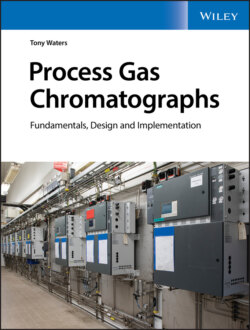Читать книгу Process Gas Chromatographs - Tony Waters - Страница 16
Chromatographic separation
ОглавлениеLet's start by looking briefly at the various forms of chromatography.
Chromatography by itself is not a complete analytical technique. It's just a way to separate one kind of molecule from another kind of molecule. Of course, for those reading this book, the reason for separating those molecules is to measure them alone, without interference from other molecules. This is the analytical use of chromatography.
While analytical measurement is the main use of chromatography, it is not the only one. Some laboratory‐scale and industrial‐scale processes use a chromatographic separation to isolate extremely pure batches of valuable chemicals. This usage is known as preparative chromatography, and it works with much larger quantities of material than analytical chromatography does. This textbook focuses on analysis, so it doesn't further discuss the preparative use of chromatography.
When used as part of an analytical technique, chromatography is a very effective way to separate the measured compounds from each other and from all the other chemical compounds present in the analyzed material. After all desired compounds have been isolated, another device measures each one independently.
Keep in mind, then, that chromatographic analysis is always a two‐stage process: first separation, then measurement.
There are many ways to produce a chromatographic separation, and they involve all possible combinations of gases, liquids, and solids. While quite different in practice, these various forms of chromatography share some common features. All practical chromatographic separations involve a fluid material moving across the surface of a stationary material.
In the formal terminology of chromatography, the moving material is the mobile phase, and the immobile material is the stationary phase.
The mobile phase may be a gas or a liquid, from which we derive the terms:
gas chromatography, in which the mobile phase is a gas.
liquid chromatography, in which the mobile phase is a liquid.
A few applications have used a supercritical fluid as the mobile phase.
This book is about the analytical use of gas chromatography for the online measurement of industrial processes. We won't be discussing liquid chromatography.
In gas chromatography, the mobile phase is always a gas, and it's common to call it the carrier gas.
The carrier gas flows through a long narrow tube called a chromatographic column, which contains the stationary phase. The stationary phase may be an adsorbent solid or a non‐volatile liquid. More about that later.
